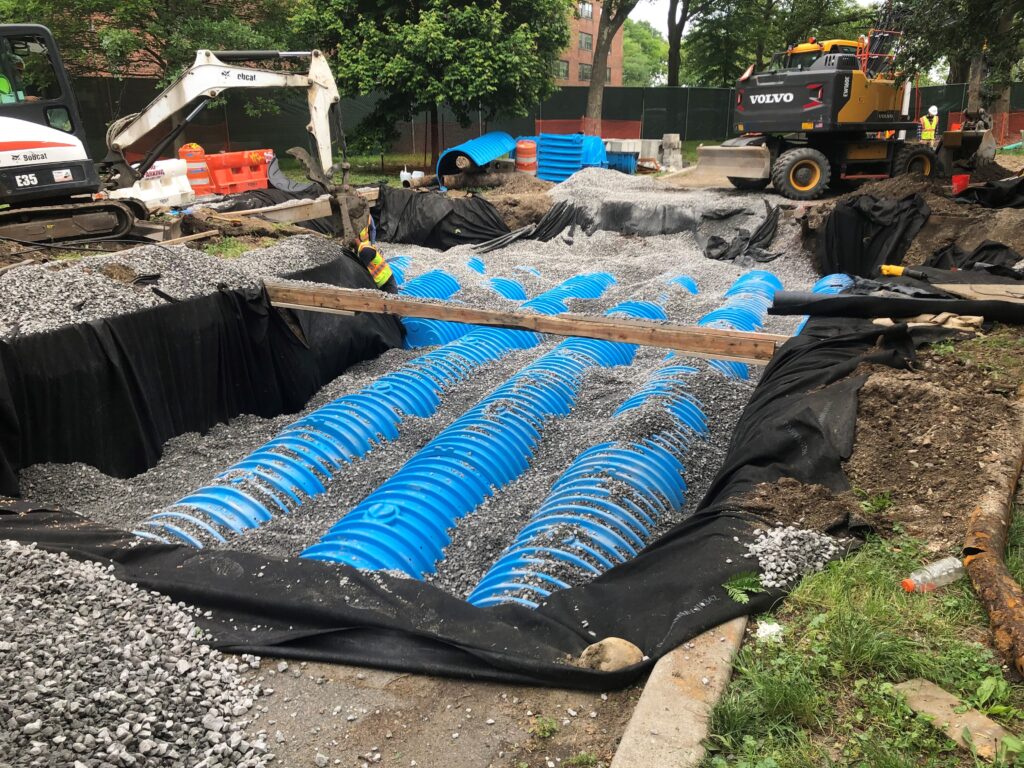Stormwater Piping & Drainage Structures

Description
- NYCHA stormwater infrastructure includes rain gardens, subsurface infiltration systems, and porous paving. NYCHA also supports right-of-way bioswales and stormwater green streets for adjacent DOT sites. Design must follow NYC DEP Office of Green Infrastructure Standards, the New York City Stormwater Manual an appendix to Chapter 19.1 of Title 15 of the RCNY, NYC DEP Green Infrastructure, NYC Environmental Protection “Rain gardens”, NYC Environmental Protection Criteria for Detention Facility Design.
- Relining of damaged or defective stormwater pipes, catch basins, stormwater inlets, manholes, etc. shall be considered. Pipe relining is the most noninvasive way to fix damaged or defective stormwater pipes If you were to consider full pipe replacements, it would mean extensive digging that is both time-consuming and damaging to the affected area. Relining plumbing pipes is a more cost-effective alternative, as plumbers use professional tools and modern technology to ensure minimal disruption.
Baseline
- Use permeable materials for hardscaped areas, rain gardens, and bioswales to dramatically increase the retention of stormwater within campuses. [CCG]
- Surface area of rain gardens shall be designed and constructed with no longitudinal or lateral slope. Parking lot or roadway runoff shall not be directed to rain gardens. Rain gardens shall be located 30 ft maximum from the downspout or impervious area treated.
- Protect existing infrastructure:
- Avoid interference with NYCHA safety and security infrastructure including electrical conduits.
- Locate at least 10 feet from any building.
- Locate at least 25 feet from MTA sites.
- Rehabilitate existing curbs to guide water flow to the new infrastructure including underground storage and retention tanks.
- Maintenance Requirements for Stormwater Management:
- Meet with NYCHA’s stormwater management partner (DEP or other agency partner) to clarify maintenance requirements given proposed size and location.
- NYCHA property management staff and/or contractors must remove all trash from the drainage areas to promote uninterrupted drainage.
- Stormwater management partner must develop educational signage and maintenance cards to facilitate communication and maintenance requirements. These should be provided to property management during turnover and signs should be posted for staff and residents, so they are clearly visible and legible.
- All roofs, paved areas, yards, parking lots, playgrounds, etc. shall drain into a separate storm sewer system, or a combined sewer system, or to a place of disposal approved by the commissioner and in accordance with the requirements of the Department of Environmental Protection.
- Designers must select and design practices to meet all applicable stormwater management requirements.
- An approved system for collection and use of storm water may be installed, in which case overflow from such a system shall be discharged to a safe location subject to the approval of the commissioner and the DEP.
- Storm water shall not be drained into sewers intended for sewage only.
- Refer to Grounds/Excavation for excavation and backfilling requirements.
Stretch
- Designers are encouraged to retain, infiltrate, and/or harvest the first inch of rainfall in a 24-hour period sitewide.
- Installation of Reuse Systems shall be considered. Reuse is the process of collecting rainfall or run off and storing it for eventual reuse in other applications.
- Reuse systems are also considered retention systems because their primary function reduces runoff. Stormwater retention systems are systems that captures rainwater or storm water runoff on site and prevents it from leaving as surface drainage. Retention systems are also known as retention basins or stormwater BMPs. They can help prevent flooding, erosion, and other property damage.
- Installation of Detention Systems shall be taking in consideration. Detention is the process of temporarily holding back stormwater so that it may be released in a controlled manner at a lower rate.
- Designers are encouraged to find appropriate opportunities to substitute porous pavement for impervious concrete or asphalt paving, and to use porous materials for playground and athletic field surfaces, where applicable and maintainable.
Strategies

Optimize Performance, Operation & Maintenance of Buildings, Systems & Assets

Prioritize Sustainable Materials, Technologies & Practices

Innovate Adaptive & Resilient Solutions
Last Updated on January 8, 2025 at 4:16 pm

















